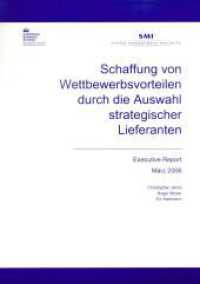- ホーム
- > 洋書
- > 英文書
- > Computer / General
Full Description
The discovery of physical systems that exhibit what we now call quantum mechanical behaviour was unquestionably one of the most astonishing events in the history of science. No less remarkable was the realisation that quantum mechanics presents a much more powerful paradigm for computation and information processing than its classical counterpart.
This textbook explores the incredible, but somewhat subtle, power of quantum computation, starting with a thorough in-depth exposition of quantum physics. Quantum mechanical behaviour is formalised by the postulates of quantum mechanics, which give rise to some startling results, such as the Bell inequalities. From the postulates of quantum mechanics, the quantum circuit model can also be derived, which enables a visual intuition for quantum computation to be acquired without any loss of rigour in the accompanying analysis.
Getting to the principal subject-matter of the book, the question of quantum advantage is tackled head-on, with the theoretical evidence that quantum computation does indeed offer a more powerful computation paradigm, paired with cautionary results that certain classes of circuits can be proven to enjoy no such quantum advantage. The book then presents a canon of the most important quantum algorithms and communication protocols that have been discovered in the relatively brief history of this exciting, emerging field. Starting with historically important query algorithms, 'classic' results such as Grover's and Shor's algorithm are then covered, followed by more recent breakthroughs including the quantum algorithm for solving linear systems (HHL) and the quantum singular value transformation.
The final chapter of the book addresses the subject of quantum error correction, building up to the celebrated 'threshold theorem', which implies that the theoretical promises of quantum computation can one day be realised on actual quantum computers.
Contents
1: Introduction
2: Linear algebra
3: Quantum mechanics and quantum information
4: Quantum circuits
5: Quantum communication protocols
6: Quantum advantage
7: Quantum algorithms for query problems
8: Quantum search
9: Quantum phase estimation and quantum amplitude estimation
10: Order finding, period finding, and quantum factoring
11: Hamiltonian simulation and ground state energy estimation
12: Quantum optimisation
13: A quantum linear system solver
14: Quantum signal processing and the quantum singular value transformation
15: An introduction to quantum error correction
Appendix A: Simulating the Hadamard gate in the quadratic form expansion






